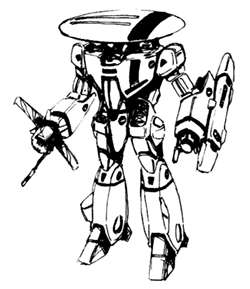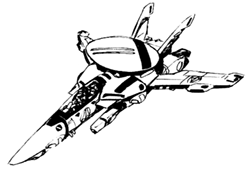Click Images For Larger View

VEFR-1 Battroid mode

VEFR-1 Fighter mode

VEFR-1 at the final battle of Space War I
|
VEFR-1 Electronic Warfare Valkyrie
Equipment Type: reconnaissance type all-environment variable fighter and tactical combat battroid
Unofficial codename: Funny Chinese
Government: U.N. Spacy, U.N. Navy, U.N. Space Air Force
Manufacturer: Stonewell/Bellcom
Introduction: November 2007
Operational Deployment: 2009 February 7
Accommodation: pilot plus passenger in Marty & Beck Mk-7 zero/zero ejection seats
Dimensions:
Battroid Mode: height 12.68 meters; width 7.3 meters; length 4.0 meters
Fighter Mode: wingspan 14.78 (fully extended); height 3.84 meters; length 14.23 meters
GERWALK Mode: wingspan 14.78 (fully extended); height 8.7 meters; length 11.3 meters
Mass: empty 13.25 metric tons; standard T-O 18.5 metric tons
Structure: space metal frame, SWAG energy conversion armor
Power Plant: two Shinnakasu Heavy Industry/P&W/Roice FF-2001 thermonuclear reaction turbine engines, output 650 MW each
Propulsion: 11,500 kg [x g] x 2; or 23,000 kg [x g] x 2 in overboost (225.63 kN x 2 overboost); 4 x Shinnakasu Heavy Industry NBS-1 high-thrust vernier thrusters; 18 x P&W LHP04 low-thrust vernier thrusters
Performance:
Battroid Mode: maximum walking speed 160 km/h
Fighter Mode: at 10,000 m Mach 2.71; at 30,000+ m Mach 3.87
GERWALK Mode: maximum walking speed 100 km/h; flying 500 km/h
g limit: in space +7
Design Features: 3-mode variable transformation; variable geometry wing; vertical take-off and landing; control-configurable vehicle; fly-by-light; rectangular underfuselage air intakes with intake vane, variable ramps, and retractable cover shutters (for Battroid mode or space use); single-axis two-dimensional thrust vectoring nozzles operate in lieu of conventional elevators and horizontal stabilizers and in tandem with wing thruster roll control system; one ventral fin under each engine nacelle; large airbrake directly rear of cockpit canopy (nozzle feet operate as airbrakes also); two-section flap (with spoiler) and fowler flap occupy almost entire wing trailing-edge; leading-edge slats; conventional rudders with honeycomb construction in outward-canted vertical tail surfaces; two cooling sub-air intake/airframe lift adjustment slits located on forward main body in Fighter mode operate in lieu of glove vanes by controlling airflow; four times the mobility of the Destroid Spartan; three "magic hand" manipulators for maintenance use; retractable canopy shield for Battroid mode and atmospheric reentry; retractable tricycle undercarriage (landing gear) with two steerable nosewheels retract rearward into nose and twin coupled mainwheels inward into fuselage; 2 x arresting hooks mounted underfuselage on engine nacelles; 2 x forward-looking infrared (FLIR) sensors in recessed emplacements within leg-joint nacelles (built below and to the fore of the cockpit canopy in egg-shaped blisters on either side of the Fighter mode nosecone); option of GBP-1S system, atmospheric-escape booster, or FAST Pack system
Transformation:
Min time from Fighter to GERWALK (automated): approx. 1.5 sec.
Min time from GERWALK to Battroid (automated): under 2 sec.
Standard time from Fighter to Battroid (automated): under 5 sec.
Min time from Fighter to Battroid (manual): 0.9 sec.
Armament: none
Equipment:
1 x Rotary Radome
1 x electronic surveillance pod (mounted on left arm)
detection equipment (mounted in each wing)
2 x retractable detectors replacing the manipulators (hands)
|
The VEFR-1 initially fulfilled the role of electronic warfare Valkyrie early in Space War One. Featuring a two-seater cockpit configuration, the VEFR-1 includes additional electronic hardware for use in reconnaissance missions as well as ECM/ECCM roles (Electronic Countermeasures/Electronic Counter-Countermeasures). Like most such dedicated craft, the VEFR-1 has no weaponry and functions strictly as a support unit, though the variable transformation is kept intact to increase battlefield deployment versatility.
|
Debut: Super Dimension Fortress Macross, Episode 27
Pilot(s): no notables
Other Appearances: none
Original mechanical designer: Shoji Kawamori
|
Information Courtesy of the Macross Compendium: www.macross.anime.net/wiki/Main_Page
Images From - The Super Dimension Fortress Macross Model Hobby Handbook 1
C. Wilson - Writer, Editor and Colorist
|
|


